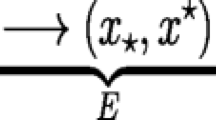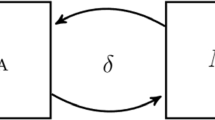Abstract
Many species are responding to global climate change by shifting their ranges poleward in latitude or upward in elevation. We analyze an integrodifference equation that combines growth, dispersal, and a constant-speed, climate-induced range shift and find that a shifting population can die out, even if the width of its range remains constant. We show how to determine the critical range-shift speed (for extinction) and study the effects of the growth rate and of the shape and scale of the dispersal kernel on persistence.






Similar content being viewed by others
References
Allee WC (1938) The social life of animals. Norton, New York
Anderson E, Bai Z, Bischof C, Blackford S, Demmel J, Dongarra J, Croz JD, Greenbaum A, Hammarling S, McKenney A, Sorensen D (1999) LAPACK user’s guide. Society for Industrial and Applied Mathematics, Philadelphia
Bakkenes M, Alkemade JRM, Ihle F, Leemans R, Latour JB (2002) Assessing effects of forecasted climate change on the diversity and distribution of European higher plants for 2050. Glob Chang Biol 8:390–407
Berestycki H, Diekmann O, Nagelkerke CJ, Zegeling PA (2009) Can a species keep pace with a shifting climate? Bull Math Biol 71:399–429
Beverton RJH, Holt SJ (1957) On the dynamics of exploited fish populations. Her Majesty’s Stationery Office, London
Box EO (1981) Macroclimate and Plant Forms: an introduction to predictive modeling in phytogeography. Dr. W. Junk, The Hague
Brent RP (1973) Algorithms for minimization without derivatives. Prentice-Hall, Inc., Englewood Cliffs
Cantrell RS, Cosner C (2003) Spatial ecology via reaction-diffusion equations. J. Wiley, Chichester
Clark JS (1998) Why trees migrate so fast: confronting theory with dispersal biology and the paleorecord. Am Nat 152:204–224
Crone EE, Schultz CB (2003) Movement behavior and minimum patch size for butterfly population persistence. In: Boggs CL, Watt WB, Ehrlich PR (eds) Butterflies: ecology and evolution taking flight. University of Chicago Press, Chicago, pp 561–576
Crone EE, Schultz CB (2008) Old models explain new observations of butterfly movement at patch edges. Ecology 89:2061–2067
Delves LM, Walsh J (1974) Numerical solution of integral equations. Clarendon Press, Oxford
Dwyer G, Morris WF (2006) Resource-dependent dispersal and the speed of biological invasions. Am Nat 167:165–176
Fagan WF, Lewis M, Neubert MG, Aumann C, Apple JL, Bishop JG (2005) When can herbivores slow or reverse the spread of an invading plant? A test case from Mount St. Helens. Am Nat 166:669–685
Fisher RA (1937) The wave of advance of advantageous genes. Ann Eugen 7:355–369
Galassi M, Davies J, Theiler J, Gough B, Jungman G, Aiken P, Booth M, Rossi F (2009) GNU scientific library: reference manual. Network Theory Ltd., Bristol
Gaston KJ (2003) The structure and dynamics of geographic ranges. Oxford University Press, Oxford
Guisan A, Thuiller W (2005) Predicting species distribution: offering more than simple habitat models. Ecol Lett 8:993–1009
Hart DR, Gardner RH (1997) A spatial model for the spread of invading organisms subject to competition. J Math Biol 35:935–948
Hastings A, Higgins K (1994) Persistence of transients in spatially structured ecological models. Science 263:1133–1136
Hastings A, Cuddington K, Davies KF, Dugaw CJ, Elmendorf S, Freestone A, Harrison S, Holland M, Lambrinos J, Malvadkar U, Melbourne BA, Moore K, Taylor C, Thomson D (2005) The spatial spread of invasions: new developments in theory and evidence. Ecol Lett 8:91–101
Horiguchi T, Fukui Y (1996) A variation of the Jentzsch theorem for a symmetric integral kernel and its application. Interdiscip Inf Sci 2:139–144
Hughes L (2000) Biological consequences of global warming: is the signal already apparent? Trends Ecol Evol 15:56–61
Hutson V, Pym JS (1980) Applications of functional analysis and operator theory. Academic Press, London
IPCC (2007) Climate change 2007: synthesis report. Contribution of working groups I, II and III to the fourth assessment report of the intergovernmental panel on climate change. Core Writing Team and Pachauri, R. K. and Reisinger, A., IPCC, Geneva
Jeffree CE, Jeffree EP (1996) Redistribution of the potential geographical ranges of mistletoe and Colorado beetle in Europe in response to the temperature component of climate change. Funct Ecol 10:562–577
Jentzsch R (1912) Über integralgleichungen mit positivem kern. J Reine Angew Math 141:235–244
Kadmon R, Farber O, Danin A (2003) A systematic analysis of factors affecting the performance of climatic envelope models. Ecol Appl 13:853–867
Kang Y, Armbruster D, Kuang Y (2008) Dynamics of a plant–herbivore model. J Biol Dyn 2:89–101
Kareiva P (1990) Population dynamics in spatially complex environments: theory and data. Philos Trans: Biol Sci 330:175–190
Karlin S (1964) The existence of eigenvalues for integral operators. Trans Am Math Soc 113:1–17
Keeling M (1999) Spatial models of interacting populations. In: McGlade JM (ed) Advanced ecological theory: principles and applications. Blackwell Science, Malden, pp 64–99
Kot M (1992) Discrete-time travelling waves: ecological examples. J Math Biol 30:413–436
Kot M, Schaffer WM (1986) Discrete-time growth-dispersal models. Math Biosci 80:109–136
Kot M, Lewis MA, Van Den Driessche P (1996) Dispersal data and the spread of invading organisms. Ecology 77:2027–2042
Kot M, Medlock J, Reluga T, Walton DB (2004) Stochasticity, invasions, and branching random walks. Theor Popul Biol 66:175–184
Krzemiński S (1977) Comment on ‘A simple proof of the Perron–Frobenius theorem for positive symmetric matrices’. J Phys A Math Gen 10:1437–1438
Latore J, Gould P, Mortimer AM (1998) Spatial dynamics and critical patch size of annual plant populations. J Theor Biol 190:277–285
Latore J, Gould P, Mortimer AM (1999) Effects of habitat heterogeneity and dispersal strategies on population persistence in annual plants. Ecol Model 123:127–139
Letcher TM (2009) Climate change: observed impacts on planet Earth. Elsevier, Amsterdam
Lewis MA (1997) Variability, patchiness, and jump dispersal in the spread of an invading population. In: Tilman D, Kareiva P (eds) Spatial ecology: the role of space in population dynamics and interspecific interactions. Princeton University Press, Princeton, pp 46–69
Lewis MA, Neubert MG, Caswell H, Clark JS, Shea K (2006) A guide to calculating discrete-time invasion rates from data. In: Cadotte MW, McMahon SM, Fukami T (eds) Conceptual ecology and invasions biology: reciprocal approaches to nature. Springer, Dordrecht, pp 169–192
Lockwood DR, Hastings A, Botsford LW (2002) The effects of dispersal patterns on marine reserves: does the tail wag the dog? Theor Popul Biol 61:297–309
Lovejoy TE, Hannah L (2005) Climate change and biodiversity. Yale University Press, New Haven
Lui R (1983) Existence and stability of travelling wave solutions of a nonlinear integral operator. J Math Biol 16:199–220
Lutscher F (2008) Density-dependent dispersal in integrodifference equations. J Math Biol 56:499–524
May RM (1973) On relationships among various types of population models. Am Nat 107:46–57
May RM, Hassell MP, Anderson RM, Tonkyn DW (1981) Density dependence in host–parasitoid models. J Anim Ecol 50:855–865
Maynard Smith J (1968) Mathematical ideas in biology. Cambridge University Press, London
McCarty JP (2001) Ecological consequences of recent climate change. Conserv Biol 15:320–331
Mitikka V, Heikkinen RK, Luoto M, Araújo MB, Saarinen K, Pöyry J, Fronzek S (2008) Predicting range expansion of the map butterfly in Northern Europe using bioclimatic models. Biodivers Conserv 17:623–641
Neubert MG, Caswell H (2000) Demography and dispersal: calculation and sensitivity analysis of invasion speed for structured populations. Ecology 81:1613–1628
Neubert MG, Parker IM (2004) Projecting rates of spread for invasive species. Risk Anal 24:817–831
Neubert MG, Kot M, Lewis MA (1995) Dispersal and pattern formation in a discrete-time predator-prey model. Theor Popul Biol 48:7–43
Neubert MG, Kot M, Lewis MA (2000) Invasion speeds in fluctuating environments. Proc R Soc Lond B 267:1603–1610
Nicholson AJ (1933) The balance of animal populations. J Anim Ecol 2:132–178
Okubo A (1980) Diffusion and ecological problems: mathematical models. Springer, Berlin
Osborne JL, Loxdale HD, Woiwod IP (2002) Monitoring insect dispersal: methods and approaches. In: Bullock JM, Kenward RE, Hails RS (eds) Dispersal ecology: the 42nd symposium of the British ecological society held at the University of Reading 2–5 April 2001. Blackwell Science, Malden, pp 24–49
Parmesan C (2006) Ecological and evolutionary responses to recent climate change. Annu Rev Ecol Evol Systemat 37:637–669
Parmesan C, Ryrholm N, Stefanescu C, Hill JK, Thomas CD, Descimon H, Huntley B, Kaila L, Kullberg J, Tammaru T, Tennent WJ, Thomas JA, Warren M (1999) Poleward shifts in geographical ranges of butterfly species associated with regional warming. Nature 399:579–583
Pearson RG, Dawson TP (2003) Predicting the impacts of climate change on the distribution of species: are bioclimate envelope models useful? Glob Ecol Biogeogr 12:361–371
Pipkin AC (1991) A course on integral equations. Springer-Verlag, New York
Potapov AB, Lewis MA (2004) Climate and competition: the effect of moving range boundaries on habitat invasibility. Bull Math Biol 66:975–1008
Press WH, Teukolsky SA, Vetterling WT, Flannery BP (1992) Numerical recipes in C: the art of scientific computing. Cambridge University Press, Cambridge
Ricker WE (1954) Stock and recruitment. J Fish Res Board Can 11:559–623
Schultz CB (1998) Dispersal behavior and its implications for reserve design in a rare oregon butterfly. Conserv Biol 12:284–292
Schultz CB, Crone EE (1998) Burning prairie to restore butterfly habitat: a modeling approach to management tradeoffs for the Fender’s blue. Restor Ecol 6:244–252
Schultz CB, Crone EE (2001) Edge-mediated dispersal behavior in a prairie butterfly. Ecology 82:1879–1892
Schultz CB, Hammond PC (2003) Using population viability analysis to develop recovery criteria for endangered insects: case study of the Fender’s blue butterfly. Conserv Biol 17:1372–1385
Schultz CB, Hammond PC, Wilson MV (2003) Biology of the Fender’s blue butterfly (Icaricia icarioides fenderi Macy), an endangered species of western Oregon native prairies. Nat Areas J 23:61–71
Shigesada N, Kawasaki K (1997) Biological invasions: theory and practice. Oxford University Press, Oxford
Shigesada N, Kawasaki K (2002) Invasion and the range expansion of species: effects of long-distance dispersal. In: Bullock J, Kenward R, Hails R (eds) Dispersal ecology. Blackwell Science, Oxford, pp 350–373
Skellam JG (1951) Random dispersal in theoretical populations. Biometrika 38:196–218
Taylor CM, Hastings A (2005) Allee effects in biological invasions. Ecol Lett 8:895–908
Turchin P (1998) Quantitative analysis of movement. Sinauer Associates, Inc., Sunderland
US Fish and Wildlife Service (2000) Endangered and threatened wildlife and plants; endangered status for Erigeron decumbens var. decumbens (Willamette daisy) and Fender’s blue butterfly (Icaricia icarioides fenderi) and threatened status for Lupinus sulphureus ssp. kincaidii (Kincaid’s lupine). Fed Regist 65:3875–3890
Van Kirk RW, Lewis MA (1997) Integrodifference models for persistence in fragmented habitats. Bull Math Biol 59:107–137
Van Kirk RW, Lewis MA (1999) Edge permeability and population persistence in isolated habitat patches. Nat Resour Model 12:37–64
Walther GR, Post E, Convey P, Menzel A, Parmesan C, Beebee TJC, Fromentin JM, Hoegh-Guldberg O, Bairlein F (2002) Ecological responses to recent climate change. Nature 416:389–395
Wang MH, Kot M, Neubert MG (2002) Integrodifference equations, Allee effects, and invasions. J Math Biol 44:150–168
Weinberger HF (1978) Asymptotic behavior of a model in population genetics. Lect Notes Math 648:47–96
Weinberger HF (1982) Long-time behavior of a class of biological models. SIAM J Math Anal 13:353–396
Westerling AL, Hidalgo HG, Cayan DR, Swetnam TW (2006) Warming and earlier spring increase western U.S. forest wildfire activity. Science 313:940–943
Wilson MV, Erhart T, Hammond PC, Kaye TN, Kuykendall K, Liston A, Robinson Jr AF, Schultz CB, Severns PM (2003) Biology of Kincaid’s lupine(Lupinus sulphureus ssp. kincaidii [Smith] Phillips), a threatened species of western Oregon native prairies, USA. Nat Areas J 23:72–83
Acknowledgements
MK acknowledges Mark A. Lewis and Michael G. Neubert for stimulating and helpful discussions that helped inspire and further this research. We are grateful to the reviewers for their helpful comments.
Author information
Authors and Affiliations
Corresponding author
Rights and permissions
About this article
Cite this article
Zhou, Y., Kot, M. Discrete-time growth-dispersal models with shifting species ranges. Theor Ecol 4, 13–25 (2011). https://doi.org/10.1007/s12080-010-0071-3
Received:
Accepted:
Published:
Issue Date:
DOI: https://doi.org/10.1007/s12080-010-0071-3




